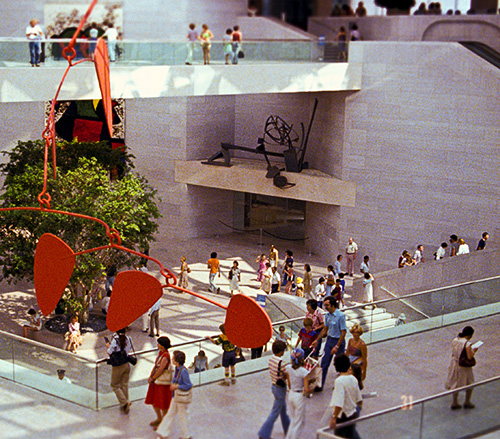2008-02-15

East Building of the National Gallery of Art in Wash., D.C.,
shortly after it opened in 1978. Taken with a Canon 110 ED.
Googling for a scanning service that could handle 110 negatives a few months ago, I came upon ScanCafe. While other scanning services argue that they're better than the cheap competition that sends the work offshore, ScanCafe, who might be the particular "cheap competition" they mean, is proud that they do all their work in a large facility of their own in Bangalore.
It might seem that you're taking a risk by sending your irreplaceable film to a foreign land, but there's no real reason why that would be any less safe than sending it across town. (In the news recently is a $54 million lawsuit against a retailer who lost a laptop sent in for repair, and it's not clear that it ever left the store—not intentionally, anyway. And, when I was living in NJ, I sent some film for processing to Baltimore that was almost lost when the processing lab closed up shop.)
My thinking is that if the film or slides are really that important, you ought to scan them yourself, and then maybe sell the scanner on eBay when you're done with it. Unfortunately, that won't work for 110 film, as no scanner manufacturer makes a tray in that size. ScanCafe must have engineered their own for their Nikon 9000 scanners.
I had prints of these old snapshots, and never was going to scan the film myself, so I sent them off to ScanCafe. I started with a batch of about a hundred, figuring that I would send more if they did OK.
Two things made me confident that all would turn out well: The ScanCafe web site is extremely well done, and they give you a lot of feedback during the process with a chart that looks like this:

Note the two UPS tracking numbers (blacked out here): One for when you send the film to ScanCafe, in California, using a label they prepare for you, and another one for the return trip. Lots of updates along the way, too, and and an email when they missed an estimated date because of the holiday rush. Note the Online flag: That's when you can view the results on their web site and choose the ones you want. You only pay for what you select, although you have to pay for at least half. The idea is that instead of selecting individual frames and making things complicated for them, you just send the whole lot and do your picking later.
I got the scans back about a week ago, so the total time was about 10 weeks. Don't use ScanCafe if you're in a rush. But these negatives have been sitting around for 30 years, so I didn't think another few months would matter. And, I did get to see some low-resolution results after about 6 weeks.
The quality was terrific, as you can see from the image above. For no extra charge they bring every image into Photoshop (Elements, I think) and spend a couple of minutes on it, but I didn't choose that option for this first batch. What you see above is as dust-free as what I got—I did no spotting at all.
Scanning 110 film is more expensive than 35mm, but it's worth it, considering how small the negatives are and how hard they are to scan. I have a 35mm job on its way back to me, and the price for that is only about 19 cents a frame, which is way lower than anyone else charges.
I think ScanCafe is a terrific service if you're willing to send the negatives or slides off somewhere, and I don't think having them sent to India increases the risk, especially as ScanCafe seems to be so communicative. The other if, of course, is that you have to wait 2 or 3 months.